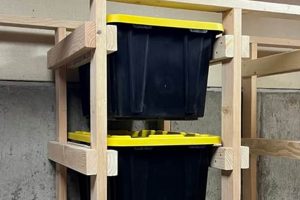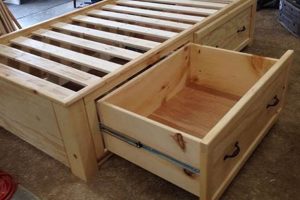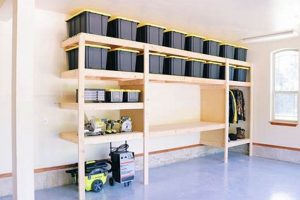The concept involves crafting personalized solutions for organizing and safeguarding phonograph records, typically utilizing readily available materials and basic tools. An example includes repurposing wooden crates or constructing shelving units tailored to specific record collection sizes and aesthetic preferences.
Effective organization preserves the condition of delicate records, preventing warping and damage. Furthermore, customized systems allow for efficient browsing and retrieval, enhancing the listening experience. Historically, enthusiasts have always sought creative means to showcase and protect their collections, adapting available resources to suit evolving needs.
The following sections will explore specific methods, material considerations, and design principles relevant to constructing individual record storage solutions, offering guidance for both novice and experienced do-it-yourself enthusiasts.
Crafting Optimal Record Organization
The following recommendations outline crucial considerations for developing effective and protective methods.
Tip 1: Material Selection: Prioritize inert materials such as solid wood or metal. Avoid acidic materials like certain types of cardboard which may degrade record jackets over time.
Tip 2: Structural Integrity: Ensure the structure can adequately support the weight of a full record collection. Improper support can lead to sagging shelves and potential damage to records.
Tip 3: Proper Spacing: Allow sufficient space between records to prevent pressure and warping. Overcrowding can compromise the integrity of the vinyl.
Tip 4: Vertical Storage: Store records vertically, never stacked horizontally. Horizontal stacking places undue pressure on lower records, leading to warping and irreversible damage.
Tip 5: Environmental Control: Maintain a consistent temperature and humidity level in the storage area. Fluctuations can adversely affect vinyl composition.
Tip 6: Accessibility: Design the structure to allow for easy browsing and retrieval. A well-organized system promotes frequent listening and reduces the risk of mishandling.
Tip 7: Dust Protection: Consider incorporating features that minimize dust accumulation, such as doors or covers. Dust contributes to surface noise and requires more frequent cleaning.
Adherence to these guidelines ensures the long-term preservation and enjoyment of a vinyl record collection.
The subsequent section offers guidance on material choices to protect record collections, ensuring longevity and maintaining the integrity of the sound quality.
1. Material Durability
The longevity of a system directly correlates with the materials employed in its construction. A robust framework safeguards records from physical harm, ensuring their condition remains optimal. Conversely, substandard materials may lead to structural failure, resulting in potential damage to the vinyl collection. For example, shelves constructed from particleboard may sag under the cumulative weight of records, while solid wood or metal provides superior support and resistance to deformation.
In the context of crafting personalized solutions, material choice becomes paramount. Considerations extend beyond cost; durability, resistance to environmental factors, and aesthetic compatibility are all crucial. The selection of a stable, inert material prevents degradation of record jackets, safeguarding them from discoloration or embrittlement. Utilizing reclaimed wood, for example, offers a sustainable option, but requires careful assessment to ensure structural soundness and the absence of potentially harmful contaminants.
In conclusion, the selection of durable materials constitutes a fundamental element in the creation of lasting record organization. Prioritizing structural integrity and material stability minimizes the risk of damage, thereby preserving the investment and enjoyment derived from a record collection. Addressing this aspect within personal design projects mitigates future complications and ensures sustained functionality.
2. Structural Support
Adequate structural support is a non-negotiable element of any effective record organization system. The considerable weight of vinyl records, when accumulated in a storage unit, necessitates a robust framework capable of bearing the load without deformation or collapse. Insufficient support poses a direct threat to the physical integrity of the records themselves, potentially leading to warping, cracking, or other forms of irreversible damage. Consequently, in the context of crafting storage solutions, the initial design phase must prioritize the calculation and implementation of appropriate support mechanisms. Failure to do so renders the entire endeavor potentially detrimental to the collection it is intended to protect. Consider, for instance, a system constructed from thin, unsupported shelving. The inevitable sagging caused by the weight of the records would exert uneven pressure, warping the vinyl over time and diminishing their playback quality.
Practical applications of structural support principles in designs involve several considerations. Material selection plays a vital role; solid wood, metal, or engineered wood products with sufficient load-bearing capacity are preferable to lightweight or flimsy alternatives. Joinery techniques, such as mortise-and-tenon joints or reinforced screw connections, must be implemented to ensure the stability of the frame. Weight distribution is another crucial factor; evenly distributing the load across the entire structure minimizes stress points and prevents localized sagging or failure. The incorporation of vertical supports, such as dividers or backing panels, further enhances structural integrity and prevents records from leaning or toppling. A real-world example would be the use of metal bracing on a long, wooden shelf to prevent bowing under the weight of several hundred records.
In summary, understanding and implementing robust structural support is paramount to the success of any system. Neglecting this aspect not only compromises the functionality of the storage solution but also jeopardizes the preservation of the record collection. By prioritizing material selection, employing appropriate joinery techniques, and ensuring even weight distribution, builders can create durable, reliable systems that safeguard their valuable vinyl for years to come. The challenge lies in balancing aesthetic preferences with practical engineering principles to achieve both form and function.
3. Space Optimization
Space optimization, in the context of crafting record solutions, is the practice of maximizing storage capacity within a given area, a critical consideration for collectors with limited living spaces. It involves thoughtful design choices that efficiently utilize both vertical and horizontal dimensions while maintaining easy access to the stored items. Inefficient allocation of space leads to wasted potential, resulting in a cluttered environment and potentially compromising the preservation of the records. Examples include utilizing wall-mounted shelving to free up floor space, constructing corner units to occupy otherwise unused areas, or building custom-sized cubbies precisely tailored to the dimensions of vinyl records. These examples showcase direct relationships with efficient organization within constraints. The absence of space optimization strategies results in collections sprawling beyond their allocated area, increasing the risk of damage and hindering accessibility.
Practical applications of space optimization principles include the implementation of modular organization systems that allow for future expansion without requiring significant restructuring. Incorporating features such as adjustable shelves or stackable units allows for adaptation to changing collection sizes and formats. Another application involves the strategic placement of storage units in underutilized areas, such as beneath staircases or within alcoves. These areas, often overlooked, can provide valuable additional capacity without encroaching on primary living spaces. Furthermore, the integration of multi-purpose furniture, such as record storage units that also serve as room dividers or seating, represents an effective space-saving solution. For instance, a custom-built bench with storage beneath the seat offers both functional seating and a concealed area for storing a portion of a vinyl collection. An ottoman with record storage can provide compact storage and seating without compromising living space.
In summary, the integration of space optimization strategies is essential for effective record organization, particularly in environments with limited square footage. Prioritizing efficient use of available space not only maximizes storage capacity but also contributes to a more organized and visually appealing living area. The challenge lies in balancing storage needs with aesthetic preferences and functional requirements, ensuring that the resulting system is both practical and visually harmonious. Ultimately, successful space optimization requires careful planning, creative design, and a commitment to maximizing the potential of every available square inch. It improves the life of the records and the owner.
4. Accessibility
The principle of accessibility, within the framework of individualized record storage, concerns the ease with which individual records can be located, retrieved, and returned to their designated place. Suboptimal accessibility directly impedes the enjoyment of the collection. A poorly designed system requiring excessive effort to locate a specific record diminishes the likelihood of frequent use and increases the risk of accidental damage during handling. Consequently, the design and execution of methods should prioritize a user-centered approach, ensuring a seamless and intuitive interaction with the collection. An example of poor accessibility is storing records in tightly packed rows on the floor, necessitating significant bending and searching. Conversely, a well-designed shelving unit with clearly labeled sections and sufficient spacing facilitates effortless browsing and selection.
Several design choices contribute directly to enhanced accessibility. Appropriate shelving height, for instance, minimizes the need for excessive reaching or bending. Clear and consistent labeling systems, employing alphabetical, genre-based, or other personally relevant classifications, enable rapid identification of desired items. Adjustable shelving allows for customization to accommodate varying record formats and spine thicknesses. Furthermore, incorporating features such as pull-out drawers or sliding shelves provides unimpeded access to records stored at the back of the unit. A real-world example of improved accessibility involves replacing a deep, static shelf with shallower, pull-out shelves, allowing for easy viewing and retrieval of records previously obscured at the back. Angled shelves provide increased visibility over standard vertical stacking.
In summary, accessibility constitutes a fundamental element of successful record organization. Prioritizing ease of use not only enhances the overall listening experience but also contributes to the long-term preservation of the collection. By carefully considering factors such as shelving height, labeling systems, and access mechanisms, designers can create systems that are both functional and enjoyable to use. Neglecting accessibility undermines the value of the collection, transforming a potential source of pleasure into a frustrating and inconvenient endeavor. Therefore, implementing designs should consider the needs of the collector alongside their functional requirements to ensure long-term usability.
5. Dust Mitigation
The accumulation of particulate matter on vinyl records and within storage units poses a significant threat to sound quality and long-term preservation. Dust particles act as abrasives, causing scratching and surface noise during playback. Furthermore, dust can harbor mold spores and other contaminants that accelerate the degradation of record jackets and vinyl composition. Therefore, effective dust mitigation strategies are a crucial component of thoughtful design for individual record storage systems. Ignoring dust control measures renders even the most aesthetically pleasing system functionally inadequate, potentially damaging the very items it is intended to protect. For instance, an open-shelved system in a high-traffic area will inevitably accumulate more dust than a closed cabinet, necessitating more frequent and meticulous cleaning to maintain optimal sound quality. This can lead to damage over time.
Practical approaches to dust mitigation within designs encompass a range of strategies. Enclosed cabinets or units with doors provide a physical barrier against airborne dust. Implementing airtight seals further minimizes the ingress of particulate matter. The selection of materials with smooth, non-porous surfaces reduces dust adhesion and simplifies cleaning. Furthermore, the strategic placement of storage units away from sources of dust generation, such as doorways or ventilation systems, minimizes exposure. Regular cleaning of both the records and the storage unit is essential. Using anti-static brushes and microfiber cloths minimizes the introduction of new contaminants during the cleaning process. Another practical application involves the use of air purifiers in the storage area to reduce airborne dust concentrations. For example, installing a cabinet with a HEPA filter is the ultimate solution. The frequency of cleaning depends on several factors, including the environmental conditions and the design of the storage unit, but a regular schedule is crucial for maintaining record quality.
In summary, dust mitigation represents a critical, often overlooked, aspect of successful record organization. The implementation of appropriate dust control measures directly impacts the longevity and sound quality of a vinyl collection. By incorporating enclosed storage, selecting appropriate materials, strategically positioning units, and maintaining a regular cleaning schedule, enthusiasts can minimize the detrimental effects of dust and preserve their valuable records for years to come. The challenge lies in integrating dust mitigation strategies seamlessly into the overall design, balancing functionality with aesthetic considerations. Ultimately, a well-designed system prioritizes both the visual appeal and the practical needs of record preservation. Regular cleaning and dusting is mandatory in preserving records.
Frequently Asked Questions About Record Organization
The following section addresses common inquiries regarding the principles and practices of personalized phonograph record organization.
Question 1: What material is most suitable for constructing record shelving to prevent damage to the vinyl?
Solid wood, metal, or high-density fiberboard (HDF) are preferred due to their structural stability and inert chemical properties. Avoid materials like particleboard or acidic cardboard, which may off-gas or degrade record jackets.
Question 2: Is horizontal stacking of records acceptable if space is limited?
No. Horizontal stacking exerts uneven pressure on the lower records, leading to warping and irreversible damage. Vertical storage is mandatory for preservation.
Question 3: What is the ideal spacing between records to prevent warping or ring wear?
Allow for a minimum of 1/8 inch (3mm) of space between records to prevent pressure and facilitate easy removal. Overcrowding compromises vinyl integrity.
Question 4: How can dust accumulation be minimized in an open-shelved system?
Regular dusting with a microfiber cloth and anti-static brush is essential. Consider using a record cleaning solution on the vinyl itself. An air purifier in the room can further reduce airborne dust.
Question 5: Are specific dimensions recommended for record storage cubbies?
Cubbies should be slightly larger than the dimensions of a standard record jacket. A minimum internal dimension of 13 x 13 x 14 inches (33 x 33 x 35.5 cm) is generally sufficient.
Question 6: What are the long-term implications of storing records in areas with fluctuating temperature and humidity?
Fluctuations accelerate vinyl degradation, leading to warping, cracking, and increased surface noise. Maintain a consistent temperature and humidity level in the storage area, ideally between 65-70F (18-21C) and 45-50% relative humidity.
Effective organization is paramount for preserving the condition of valuable records and maximizing the listening experience.
The subsequent section provides a summary of the key recommendations for building individualized record solutions.
Effective Record Organization
This exploration of “diy vinyl storage ideas” has emphasized critical elements: material selection, structural support, space optimization, accessibility, and dust mitigation. Prioritization of these aspects yields a storage solution that not only accommodates a collection but actively contributes to its preservation. Construction from durable, inert materials ensures long-term stability. Maximizing space allows for growth without compromising accessibility. Mitigation of dust protects against degradation.
The creation of individualized solutions demands a commitment to both functionality and preservation. Thoughtful planning and meticulous execution are essential. The long-term value of a record collection hinges on its proper care and storage. Implementation of the discussed principles ensures the continued enjoyment of a tangible artistic medium.






![Build Your Own! Storage Bin Rack DIY Project [Easy] The DIY Hub: Creative Crafts, Repairs & Life Hacks Build Your Own! Storage Bin Rack DIY Project [Easy] | The DIY Hub: Creative Crafts, Repairs & Life Hacks](https://craftingdiycenter.com/wp-content/uploads/2025/07/th-1825-300x200.jpg)
